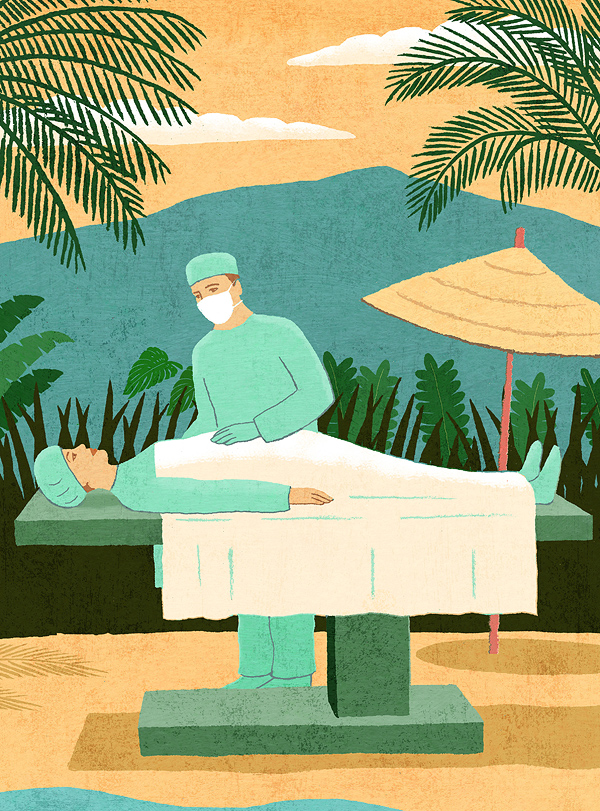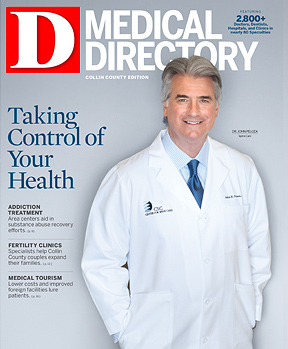Like many Americans, Mckinney resident Jorga Clark struggled with her weight, which led to high blood pressure and diabetes. After several unsuccessful diets, her Plano internal medicine physician recommend “one last shot:” bariatric surgery.
Clark, 64, says her “really good health insurance” did not cover the procedure, which runs about $12,000.
“That’s a lot out-of-pocket,” she says. “But this was important for my health.”
Clark began shopping on the Internet and concluded that having the procedure done internationally was the answer. She contacted Medical Tourism Connection in Fort Worth to help set it up. The company gave her possible destinations and estimated pricing. She chose Mexico—specifically, Cancun—because she had been there before and the tourism aspect was important to her.
Medical Tourism Connection then provided Clark with a list of facilities and physicians in Cancun. After reviewing their credentials and outcomes, she narrowed the search to two facilities and a physician who practiced at both. The Fort Worth company helped her set up telephone interviews with the practice managers and the physician.
Clark left a deposit with Medical Tourism Connection and flew to Cancun for her final due diligence. Once her onsite visit confirmed her prior research, she released the funds and had the procedure performed.
The result: Clark has lost 47 pounds in four months, and she is no longer taking prescription medicine for her high blood pressure and diabetes.
The cost: $7,000 for the procedure and an eight-day resort stay in Cancun, or $5,000 less than what she would have spent for the procedure alone in Plano. Her Mexican physician, who had performed bariatric surgery for 20 years, “provided excellent care,” Clark says. “The hardest part was making the [initial] decision.”
As U.S. healthcare costs continue to soar and international facilities improve, international medical tourism is expected to become an increasingly attractive alternative.
Americans traveling abroad for elective medical procedures fell by about 13 percent during the recession from 2007 to 2009, according to the Deloitte Center for Health Solutions. However, Deloitte expects the number of U.S. medical tourists to rise by 35 percent this year—and annually for the foreseeable future—because it offers savings of as much as 70 percent.
Cost Savings, Privacy
Low administrative and medical liability costs for overseas practitioners contribute to the affordability of procedures. For example, the professional liability insurance premium for a surgeon in India is about 4 percent of what a New York surgeon pays.
And patients are willing to board a plane to save. According to a 2009 Gallup poll, 40 percent of Americans said they would travel abroad to treat a major medical problem if the quality were the same as that in the U.S. and the price was cheaper.
Others go abroad for reasons other than price. Some—especially those seeking plastic surgery, sex-change operations, and substance-abuse rehabilitation—do so for privacy and confidentiality.
Neil Fettig, Medical Tourism Connection chief executive officer, says the company is part of a medical concierge service called Global Healthcare Now. Like Clark, members pay a $49.95 monthly membership fee for medical tourism assistance, as well as domestic medical consumer services, such as medical bill reviews, scheduling physician and dental appointments, and shopping for healthcare values. Fettig says Clark has saved $18,000 with her membership.
Fettig began marketing Global Healthcare Now in 2010. Sales jumped 300 percent in 2011 and are on track to experience a more than tenfold increase in 2012. He forecasts revenue of more than $3 million in 2013.
Medical tourism began garnering lots of publicity in 2008, at a time when the marketplace was chaotic, Fettig says.
“There was no infrastructure to support or a way to market to consumers,” he says. “One of the hindrances is that it’s not easy to do on your own. You’re not aware of the destinations available and you may have to get financing. Some people can’t get a clarified price, so they forego care.”
Clark agrees: “I wouldn’t have done it without that [medical tourism assistance] piece. I wouldn’t have gotten the data on my own. … I’d still be on the Internet doing research.”
Fettig says he invested more than $1 million to create his software-based company, to give it the same feel as a travel website, such as Expedia’s.
“I was able to give international hospitals and doctors an instant medical tourism department,” he says. And for consumers, “this is the way medicine is supposed to be—between you and your provider.”
Medical Tourism Connection has data on providers in 320 cities in 65 nations worldwide. Fettig does not charge the providers a fee or keep a portion of the bill.
The more popular consumer requests are for dental procedures, bariatric surgery, and cosmetic surgery.
“What I hear most often is, ‘I want cheap,’” Fettig says.
His company ran a special at the end of 2011 for $499 Lasik surgery in both eyes for people with flexible spending accounts who had to use-it-or-lose-it by the end of the year. The procedure was done by a U.S.-trained physician in Mexico.
Medical tourism patients tend either to be working-class adults with no or inadequate insurance benefits, or those seeking procedures that customarily are not covered by insurance. Most international surgeries are non-emergency or elective procedures. Popular treatments include dentistry work, laser eye surgery, hip or knee replacements, and gastric bypass.
A key driver of medical tourism is the increased demand for outpatient surgery. The number of outpatient procedures done in the U.S. tripled between 1999 and 2005. Advanced medical technology has allowed patients to go home just hours after a procedure, rather than several days. Outpatient surgeries account for about 75 percent of medical tourism procedures, in part because the out-of-pocket payments are relatively high in the U.S.
Courting International Patients
What is likely to have the greatest impact on medical tourism is whether employers and commercial health plans will recognize and embrace the value proposition of low costs and, in many cases, apparently comparable quality.
In a 2008 study, Deloitte identified 10 regional hubs for international medical tourism. Estimated costs in those areas ranged from 20 percent to 50 percent of those in the United States. According to travel insurer Mondial USA, the top 10 most popular destinations are Mexico, Costa Rica, Thailand, India, Turkey, Ireland, South Korea, Singapore, Taiwan, and Germany.
India has been especially aggressive in courting international patients. The Confederation of Indian Industry was predicting it would generate $2 billion by 2012. Cardiac surgeries there cost less than one-fifth of what they do in the United States, orthopedics about one-fourth as much, and cataract surgery about one-tenth.
India has 13 hospitals accredited by the Joint Commission, underscoring that it provides value by combining low cost with quality. Such accreditation is critical because it can give consumers a level of confidence that services are comparable to those in U.S. facilities.
Although some agencies promote the “tourism” angle of international care, the recreational value is secondary for patients with complex medical problems or those seeking less expensive care.
Even in those cases, a price break is not enough. International physicians and hospitals understand that they must provide high-quality care to maintain a competitive advantage with comparable U.S. facilities.
The direction of medical tourism is opposite of the traditional model. The U.S. used to be a net exporter of medical services, with well-heeled international patients seeking high-quality care and shorter waiting times at gold-plated U.S. medical centers. That still happens, but it pales in comparison to the number of Americans seeking bargains overseas.
Mexico is the most frequent international medical destination for Texas residents. There are no specific statistics on how pervasive this is. However, the Mexican government expects the number of U.S. medical tourists to reach 650,000 by 2020. Mexican dentists charge one-fourth to one-fifth of U.S. prices.
Many who go to Mexico for care say they are satisfied. A report by Families U.S.A., a Washington healthcare advocacy group, says, “About 90 percent felt the care they received in Mexico had been good or excellent. About 80 percent rated the care they had received in the United States as good or excellent.”
In 2005, Texas legislators explored the possibility of allowing health maintenance organizations to operate on both sides of the border. South Texas physicians lobbied against the legislation, arguing they could not compete with the lower prices in Mexico, and it never became law.
Mexico is hardly a third-world medical destination. Many of its hospitals equal or surpass those in the United States. A significant number are U.S.-owned, and many of the doctors trained in America. Some advanced equipment is more accessible in Mexico than in the U.S. For example, Mexico was performing lap-band surgery long before the FDA allowed the procedures in 2001, driven by the fact that Mexico has the world’s highest rate of diabetes.
Irving-based Christus Health, which is the largest nonprofit healthcare provider in Texas, is also the second-largest private healthcare provider in Mexico. It has had a seven-hospital joint venture there since 2001. It no longer has a medical travel program, but when it did, Christus was able to offer a savings of 25-35 percent compared with those done in the U.S.
The Downside
Medical tourism is not without risks. After returning home, patients are unable to have the same contact with their surgeon in case of complications or infections. The U.S. government cautions that there are different malpractice laws in each nation.
The American Medical Association has issued guidelines for patients traveling outside the U.S. for medical care. Among them:
– Financial incentives to leave the U.S. should not inappropriately limit diagnostic or therapeutic alternatives, or restrict treatment.
– Care should be at institutions accredited by recognized international accrediting bodies.
– Local follow-up care should be coordinated and financing arranged to ensure care continuity.
– Patients should be informed of rights and legal recourse before traveling outside the United States for care.
– Patients should have access to physician licensing and outcomes data, as well as facility accreditation and outcomes data.
– Transfer of patient medical records should be consistent with HIPAA guidelines to ensure privacy.
– Patients should be informed of the potential risks of combining surgical procedures with long airline flights and vacation activities.
Frisco plastic surgeon Alan Greenberg, MD, warned in a 2012 blog against lax regulations and protocols in other nations. He says traveling a long distance and staying in a foreign nation for an extended period after surgery “can put you at risk for infection and post-op problems. If you need a longer recovery or additional care, you may have to rely on medical personnel that you cannot check out beforehand. Even if you research the surgeon before your trip, you won’t have a chance to meet until you actually arrive at your destination, which is a risky proposition.”






